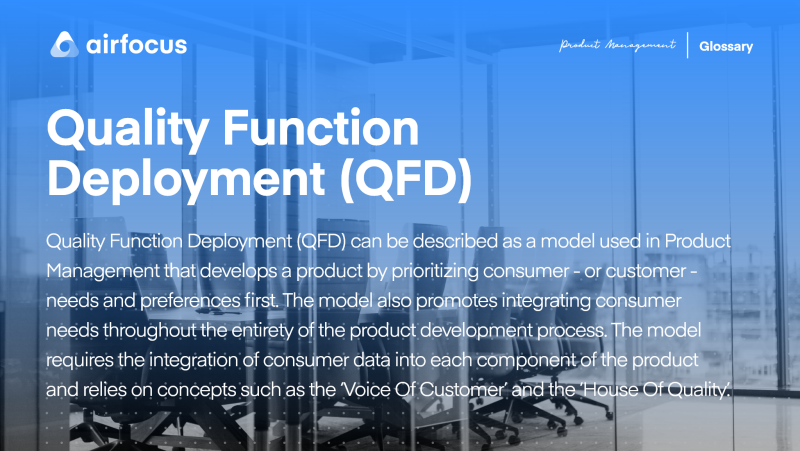Quality Function Deployment (QFD)
What is Quality Function Deployment (QFD)?
Definition of Quality Function Deployment (QFD)
Quality Function Deployment can be described as a model used in Product Management that develops a product by prioritizing consumer - or customer - needs and preferences first. The model also promotes integrating consumer needs throughout the entirety of the product development process. The model requires the integration of consumer data into each component of the product and relies on concepts such as the ‘Voice Of Customer’ and the ‘House Of Quality’.
The model was devised in the 1960s in Japan by a developer called Yoji Akao, who, with Shigeru Mizuno, founded the Quality Function Deployment Institute. Ultimately, the model became widespread due to its success in the automotive industry.
How Does QFD Work?
The initial part of the quality function deployment framework involves collecting feedback from the ultimate consumers of the product. This is achieved in a number of traditional ways through questionnaires, surveys, market research, etc. The resulting dataset should be large enough that it will offset any deviations or outliers within it, and also make it possible to formulate high-level strategic objectives.
The Voice Of Customer is created by analyzing the data. These are the preferences, needs, and requirements of the consumer. The analysis will rank these by importance and then prioritize them. The preferences of the consumer are then placed in a matrix called the House Of Quality. The matrix is also populated with the known capabilities of the organization at each step of the product development process. The matrix then makes it possible to cross-reference the needs of the consumer against that which the business can achieve. By doing this, the matrix reveals the best product the organization is able to create for the consumer and enables the integration of the consumer needs and wants throughout the development of the product.
The quality function deployment framework is based very much on the quantitative. It attempts to process data and then construct a diagnostic tool to identify the strength of each consumer requirement against the business’ potential - within the product development process - to deliver it.
Benefits and Drawbacks
The concept provides a tool for the business for maintaining their focus on the consumer. As a framework or concept, rather than a process, the business can refer back to it at all stages of the product development process. The development of the product remains sensitive to the dictates of the market through robust alignment to the needs of the consumer. It enables the business to identify any activity that does not follow the consumer-driven strategic objectives of the product, and by doing this, the product can be brought to the marketplace faster, development is more efficient, and the wholesale development of the product is less costly.
By collecting consumer data and broadly applying it across the product’s development, the various groups and departments involved need to collaborate more closely. Therefore, communication throughout the business is enhanced as conforming to the organization’s strategic objectives is made easier.
A drawback of the framework is its dependency on the consumer. A product may be successful by controlling and driving consumer behavior but the quality function deployment concept is solely reactionary: where the consumer communicates a want, it is translated into a technical requirement of the product. It is possible that the consumer will not be aware of a need or desire they have. Using the QFD, commercial opportunities that exist beyond the consumer’s perception cannot be investigated and will be lost.
A business that uses the quality function deployment must make sure that its practices for the collection of consumer data are robust and reviewed regularly. Since the QFD is dependent on customer data, the concept is also dependent on a company’s ability to collect and analyze that data proficiently. Not doing so can compromise the organization’s development of the product.

General FAQ

Glossary categories
Experience the new way of doing product management

Experience the new way of doing product management








